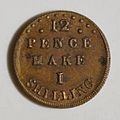£sd facts for kids
£sd (pronounced "L.s.d.") was the old money system used in the United Kingdom and many parts of the British Empire before 1971. This abbreviation stood for "pounds, shillings, and pence". It was very different from how money works today, especially compared to currencies like the United States dollar.
Contents
What Was £sd Money?
The £sd system had three main parts:
- Pounds (£): This was the largest unit of money, just like the pound is today. The symbol "£" comes from the Latin word libra, which means "pound" in weight.
- Shillings (s): This was a smaller unit. There were 20 shillings in one pound. The "s" for shilling also comes from the Latin word solidus, which was an old Roman coin.
- Pence (d): This was the smallest unit. There were 12 pence in one shilling. The "d" for pence comes from the Latin word denarius, another ancient Roman coin.
Counting with £sd
Counting money in the £sd system was a bit more complex than today's decimal system. Here's how it worked:
- 12 pence made 1 shilling.
- 20 shillings made 1 pound.
- This meant that 1 pound was equal to 240 pence (because 20 shillings multiplied by 12 pence per shilling equals 240 pence).
For example, if something cost 3 shillings and 6 pence, it would be written as 3s 6d. If something cost 2 pounds, 5 shillings, and 9 pence, it would be written as £2 5s 9d. It took a bit of practice to add and subtract these different units!
A Look Back: The History of £sd
The £sd system had a very long history. It was used in Britain for over 1,000 years, going all the way back to the time of the Roman Empire. The names of the coins, like "denarius" for pence, show these ancient roots.
As the British Empire grew, the £sd system was adopted in many other countries around the world. Places like Australia, New Zealand, South Africa, and Ireland all used pounds, shillings, and pence for their money for a long time.
Why Did It Change?
Over time, many countries started using a "decimal" money system, where everything is based on units of 10 or 100. For example, in the United States, 100 cents make 1 dollar. This makes calculations much easier, especially with the rise of computers and international trade.
The United Kingdom decided to switch to a decimal system too. This big change happened on 15 February 1971, a day often called "Decimal Day". After this date, 100 new pence made 1 pound, just like today. This made money calculations simpler for everyone.
Images for kids
-
A sampler in the Guildhall Museum of Rochester illustrates how to convert between pence, shillings, and pounds.
-
A Carolingian denarius, an ancient coin that gave its name to the "pence" (d) in £sd.
See also
 In Spanish: £sd para niños
In Spanish: £sd para niños







